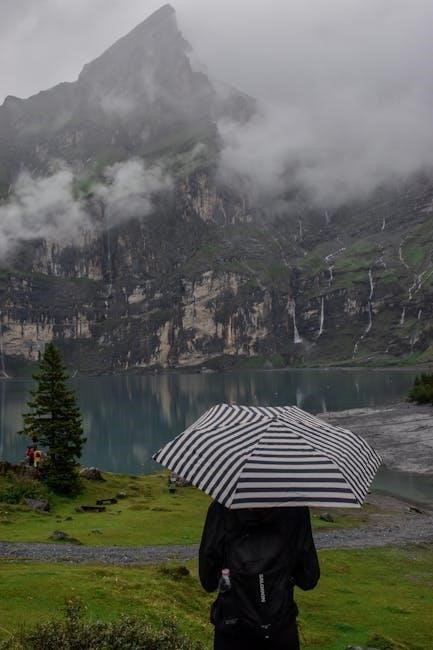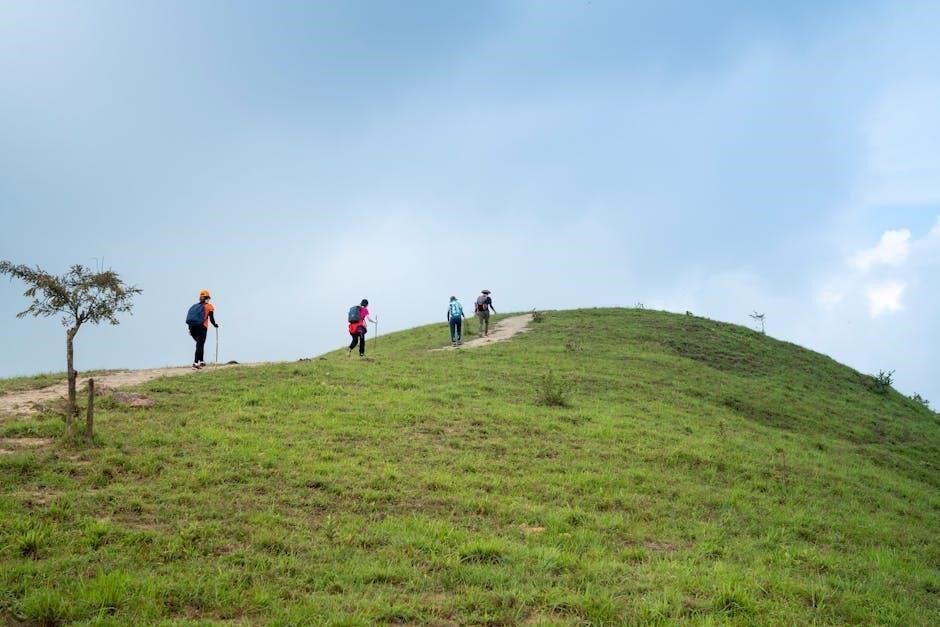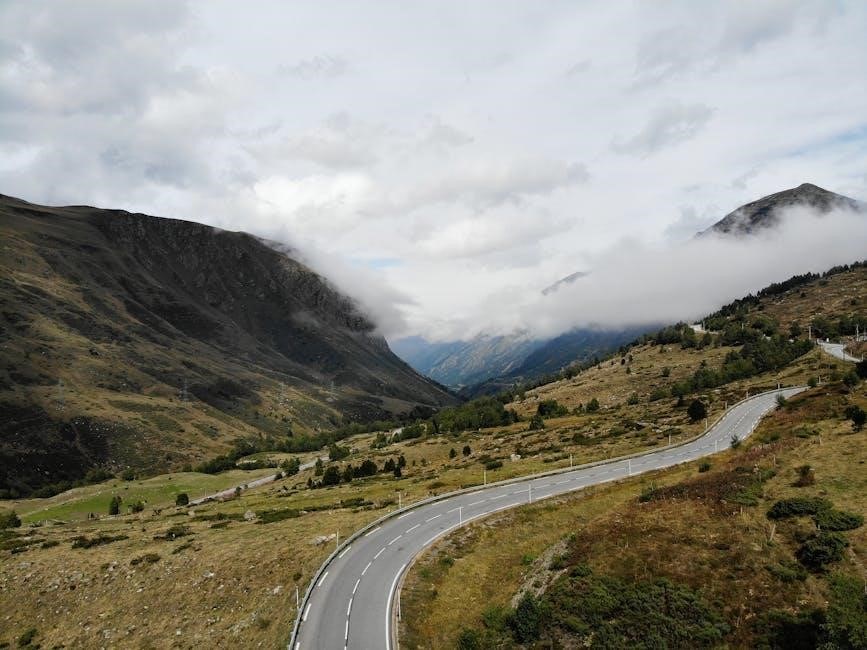N. Scott Momaday’s The Way to Rainy Mountain blends Kiowa myths, history, and personal memoir, exploring cultural identity and ancestral roots through a lyrical, tri-voiced narrative.
Overview of the Book
The Way to Rainy Mountain is a deeply personal and cultural narrative by N. Scott Momaday, blending myth, legend, and autobiography. The book explores the history and traditions of the Kiowa people, reflecting on their migration to the Southern Plains and their spiritual connection to the land. Momaday weaves together stories of his ancestors, particularly his grandmother, with historical events that shaped the Kiowa identity. The narrative is structured around a journey to Rainy Mountain, a sacred site in Oklahoma, symbolizing both loss and resilience. Through lyrical prose, Momaday honors his heritage while grappling with the challenges of cultural preservation. The book is a poignant tribute to the endurance of the Kiowa spirit and a meditation on the intersection of history, culture, and personal memory.
Author N. Scott Momaday
N. Scott Momaday, a celebrated Kiowa novelist, poet, and essayist, is best known for his Pulitzer Prize-winning novel House Made of Dawn. Born in 1934, Momaday’s work is deeply rooted in his Kiowa heritage and explores themes of cultural identity, nature, and resilience. His unique voice bridges traditional oral storytelling with modern literary techniques. In The Way to Rainy Mountain, Momaday draws from family history and tribal legends, creating a narrative that honors his ancestors while reflecting on the challenges of cultural preservation. His writing is characterized by lyrical prose and a profound connection to the land, making him a pivotal figure in Native American literature. Momaday’s work continues to inspire readers and scholars alike, offering insights into the rich cultural tapestry of the Kiowa people.
Significance of the Title
The title The Way to Rainy Mountain holds deep cultural and symbolic meaning, reflecting the journey of the Kiowa people and their connection to the land. Rainy Mountain, located in Oklahoma, is a sacred site in Kiowa tradition, representing a bridge between the physical and spiritual worlds. The title encapsulates themes of migration, heritage, and resilience, drawing from the tribe’s history of displacement and their enduring bond with their ancestral homeland. It also symbolizes a personal and collective quest for identity, as the narrator traces his roots and honors his ancestors. The title’s simplicity belies its profound significance, inviting readers to embark on a transformative journey through time, culture, and memory.

Historical and Cultural Context
The Way to Rainy Mountain reflects the Kiowa people’s rich oral traditions and their historical journey across the Plains, exploring themes of migration, cultural preservation, and resilience.
Kiowa Tribe and Their Heritage
The Kiowa Tribe, originally from the northern Plains, migrated to Oklahoma, where they developed a rich culture centered on oral storytelling, rituals, and a deep connection to nature. Their heritage, as depicted in The Way to Rainy Mountain, is marked by resilience and a strong spiritual bond with the land. The Kiowa people have preserved their traditions through generations, despite historical challenges like forced relocation and cultural suppression. Their stories, such as the legend of the Daughters of the Sun, reflect their belief in a sacred universe and the importance of communal identity. This cultural legacy continues to inspire and inform contemporary Kiowa life.
Momaday’s Connection to the Kiowa People
N. Scott Momaday, a Kiowa novelist and poet, draws deeply from his ancestral heritage in The Way to Rainy Mountain. As a member of the Kiowa Tribe, Momaday’s work reflects his profound connection to his people’s history, traditions, and spiritual beliefs. His grandmother, Aho, a central figure in the book, embodies the Kiowa storytelling tradition, which Momaday carries forward. His journey to Rainy Mountain, a sacred Kiowa site, is both a personal pilgrimage and a tribute to his ancestors. Momaday’s unique voice bridges the past and present, weaving together myth, history, and autobiography to honor the Kiowa legacy. This connection to his heritage is central to his identity and the narrative’s emotional and cultural depth.

Historical Events Shaping the Narrative
The narrative of The Way to Rainy Mountain is deeply influenced by the historical events that shaped the Kiowa people’s journey. The forced relocation from their ancestral lands to Indian Territory, the devastating impact of colonial expansion, and the loss of cultural autonomy are central themes. The Trail of Tears and the suppression of Native American traditions resonate throughout the book. Momaday reflects on the resilience of the Kiowa people in the face of displacement and cultural erasure. These events form the backdrop of the story, blending historical facts with personal and communal memory. The book serves as a testament to the enduring spirit of the Kiowa people and their connection to their heritage, despite the trials imposed by historical forces.
Literary Style and Structure

Momaday’s work combines myth, legend, and autobiography, featuring lyrical prose and multiple narrative voices. The structure blends historical and personal accounts, creating a layered, evocative storytelling experience.
Blend of Myth, Legend, and Autobiography
In The Way to Rainy Mountain, Momaday masterfully intertwines Kiowa myths, historical legends, and personal autobiographical elements. This blend creates a rich narrative tapestry that explores the Kiowa people’s cultural identity and their deep connection to the land. The myths and legends provide a historical and spiritual foundation, while the autobiographical details add a personal and emotional depth. By weaving these elements together, Momaday offers a unique perspective on the Kiowa’s journey, migration, and resilience. The book not only preserves Kiowa heritage but also connects the past with the present, making it a significant work in Native American literature. This approach highlights the importance of storytelling in preserving cultural traditions and individual experiences.
Use of Multiple Narrative Voices
N. Scott Momaday employs three distinct narrative voices in The Way to Rainy Mountain, each serving a unique purpose. The first voice represents the ancestral and collective memory of the Kiowa people, drawing from their oral traditions and myths. The second voice provides historical context, detailing the Kiowa’s migration and struggles. The third voice is deeply personal, reflecting Momaday’s own journey and emotional connection to his heritage. This interplay of voices creates a layered narrative that bridges the past and present, offering a multidimensional exploration of Kiowa identity and experience. The use of multiple voices enriches the storytelling, making the book a powerful blend of history, culture, and personal reflection.
Symbolism in the Book

The Way to Rainy Mountain is rich in symbolism, with natural elements and landmarks serving as potent metaphors. Rainy Mountain itself symbolizes the spiritual and ancestral heart of the Kiowa people, embodying their history and identity. The journey to the mountain represents a pilgrimage, both physical and spiritual, connecting the narrator to his heritage. The plains and vast landscapes symbolize the Kiowa’s deep relationship with nature, while specific animals and natural phenomena carry cultural and spiritual significance. These symbols weave together to illustrate themes of resilience, cultural preservation, and the enduring bond between the Kiowa and their land. Momaday’s use of symbolism adds depth and emotional resonance to the narrative, making it a powerful exploration of identity and tradition.

Key Themes in the Book
The Way to Rainy Mountain explores themes of cultural identity, the connection to nature, migration, and resilience, reflecting the Kiowa people’s enduring spirit and bond with their ancestral land.
Cultural Identity and Preservation
The Way to Rainy Mountain deeply explores the cultural identity of the Kiowa people through their myths, legends, and historical experiences. By blending personal and collective narratives, Momaday highlights the importance of preserving ancestral traditions and language. The book reflects the Kiowa’s strong connection to their land and their resilience in the face of displacement and cultural erosion. Momaday’s journey to Rainy Mountain symbolizes a return to roots, emphasizing the need to honor and protect indigenous heritage. The narrative voices—ancestral, historical, and personal—underscore the communal memory and shared identity of the Kiowa. Through this work, Momaday not only preserves his people’s history but also educates readers about the richness of Native American culture, ensuring its legacy endures for future generations.

Connection to Nature and the Land
In The Way to Rainy Mountain, the land is a central character, deeply intertwined with the Kiowa people’s identity and spirituality. The Wichita Mountains, the plains, and Rainy Mountain itself are not just settings but living entities that hold cultural and religious significance. Momaday’s vivid descriptions of the landscape highlight the Kiowa’s profound connection to nature, which is both a source of sustenance and a repository of their history. The book emphasizes how the land shapes their traditions, stories, and way of life. This connection is not merely physical but spiritual, reflecting a belief that nature and humanity are inseparable. Through this portrayal, Momaday underscores the importance of preserving the natural world and the cultural heritage it embodies.
Migration and Displacement
The Way to Rainy Mountain vividly portrays the Kiowa people’s migration from the mountains to the Southern Plains, a journey shaped by both adventure and necessity. This relocation, driven by environmental and cultural pressures, marked a pivotal shift in their way of life. The narrative reflects on the emotional and spiritual toll of leaving ancestral lands, as well as the resilience required to adapt to a new environment. Momaday’s account highlights the historical displacement of Native American tribes, emphasizing how such movements reshaped their identities and traditions. The book serves as a poignant reminder of the enduring impact of migration on cultural heritage and communal memory, blending personal and collective experiences to illuminate this transformative era.

Loss and Resilience
The Way to Rainy Mountain profoundly explores themes of loss and resilience, reflecting the Kiowa people’s struggles with cultural decline and personal bereavement. The death of Momaday’s grandmother symbolizes the fading of traditional ways of life, while the tribe’s historical displacement underscores broader losses. Yet, amidst sorrow, the narrative emphasizes resilience, as the Kiowa adapt to change while preserving their heritage. Through shared stories and ancestral memories, the community finds strength, illustrating how loss can foster unity and cultural renewal. The book ultimately celebrates the enduring spirit of a people navigating profound change, blending grief with hope to honor their past and secure their future.
Personal Reflections and Memoir Elements
Momaday’s personal journey to Rainy Mountain intertwines family history, emotional depth, and cultural legacy, creating a poignant memoir that bridges individual memory with collective Kiowa heritage.
Momaday’s Journey to Rainy Mountain
N. Scott Momaday’s journey to Rainy Mountain is a deeply personal pilgrimage, driven by the death of his grandmother, Aho. This trip serves as a catalyst for his exploration into Kiowa history, folklore, and family legacy. Through his travels, Momaday reconnects with the land and the stories of his ancestors, weaving together historical accounts, myths, and autobiographical reflections. The journey becomes a metaphor for the Kiowa people’s migration and resilience, highlighting their enduring connection to the land. Momaday’s experiences are intertwined with the collective memory of his tribe, creating a narrative that is both intimate and expansive, bridging the past and present.

The Role of Family and Ancestors
In The Way to Rainy Mountain, family and ancestors are central to N. Scott Momaday’s exploration of identity and heritage. His grandmother, Aho, emerges as a pivotal figure, embodying the wisdom and resilience of the Kiowa people. Through her stories and legacy, Momaday connects with his ancestral roots, preserving the tribe’s history and traditions. The narrative often reflects on the importance of familial bonds, as well as the collective memory of the Kiowa, passed down through generations. Momaday’s journey to Rainy Mountain is not just a personal pilgrimage but also a tribute to his ancestors, whose voices and stories shape the book’s themes of cultural preservation and resilience.
Autobiographical Elements in the Narrative
N. Scott Momaday weaves autobiographical elements seamlessly into The Way to Rainy Mountain, drawing from his personal experiences and connection to his Kiowa heritage. The narrative is deeply influenced by his childhood, particularly the stories of his grandmother, Aho, who played a crucial role in preserving Kiowa traditions. Momaday’s journey to Rainy Mountain, where his grandmother was buried, serves as a catalyst for the book, blending personal reflection with historical and cultural narratives. By intertwining his own identity with the collective memory of the Kiowa people, Momaday creates a rich tapestry that explores themes of loss, resilience, and cultural preservation. The autobiographical elements add a deeply personal and emotional layer to the story, making it a poignant tribute to his heritage.
Narrative Structure and Voices
The Way to Rainy Mountain features a unique narrative structure with three distinct voices: the ancestral, historical, and personal, blending myth, memory, and cultural identity seamlessly.
The Three Voices in the Story
In The Way to Rainy Mountain, N. Scott Momaday employs three distinct narrative voices to weave a rich tapestry of Kiowa culture, history, and personal reflection. The first voice represents the ancestral tradition, drawing from Kiowa myths, legends, and the collective memory of the tribe. The second voice provides historical context, detailing the migration of the Kiowa people and their struggles, while the third voice is deeply personal, reflecting Momaday’s own experiences and emotional connection to his heritage. This layered narrative structure allows for a profound exploration of identity, blending the timeless stories of the past with the intimate journey of the present. Together, these voices create a captivating and deeply moving account that honors the resilience and spirit of the Kiowa people.
Interplay Between History and Personal Experience
N. Scott Momaday masterfully intertwines historical narratives with personal reflections in The Way to Rainy Mountain, creating a vivid exploration of Kiowa identity. The book weaves together the collective memory of the Kiowa people, including their migration to the Southern Plains and their struggles with displacement, alongside Momaday’s personal journey to Rainy Mountain. His pilgrimage to his grandmother’s grave serves as a catalyst for this blending of past and present, where ancestral stories and historical events converge with intimate, emotional recollections. This interplay not only enriches the narrative but also deepens the reader’s understanding of the Kiowa experience, illustrating how individual lives are shaped by cultural heritage and historical forces. Through this fusion, Momaday honors both his ancestors and the enduring spirit of his people.
Chronological and Thematic Organization
N. Scott Momaday’s The Way to Rainy Mountain is structured into three main sections, each reflecting a distinct phase in the narrative journey. The first part delves into the historical and mythological origins of the Kiowa people, tracing their migration from the Montana region to the Southern Plains. The second section focuses on the personal and familial experiences of Momaday, particularly his connection to Rainy Mountain and his grandmother. The final part blends these elements, creating a seamless transition between past and present. This chronological and thematic organization allows Momaday to explore themes of identity, migration, and cultural preservation while maintaining a cohesive narrative flow. The structure enhances the book’s emotional and intellectual depth, making it a powerful exploration of heritage and resilience.

Reception and Impact
The book garnered widespread acclaim for its blend of myth and memoir, profoundly influencing Native American literary studies and educational programs nationwide.
Critical Acclaim and Reviews
The Way to Rainy Mountain received widespread critical acclaim for its unique blend of myth, legend, and autobiography. Reviewers praised Momaday’s lyrical prose and his ability to weave together personal and cultural narratives. The book was celebrated for its contribution to Native American literature, offering a profound exploration of identity, tradition, and resilience. Scholars highlighted its innovative structure, which combines historical accounts with intimate memoir elements. The work has been widely adopted in educational curricula, enriching discussions on indigenous cultures and storytelling. Its impact extends beyond literature, fostering a deeper understanding of the Kiowa people’s history and their connection to the land. The book’s legacy endures as a testament to Momaday’s masterful storytelling and its cultural significance.
Influence on Native American Literature
The Way to Rainy Mountain has profoundly influenced Native American literature, setting a new standard for blending cultural narratives with personal storytelling. Momaday’s work inspired a generation of Native American writers to explore their heritage and identity through literature. By integrating Kiowa myths, legends, and history, the book provided a powerful template for preserving indigenous cultures. Its innovative structure and lyrical prose have been widely emulated, shaping the direction of contemporary Native American writing. The book’s success also highlighted the importance of indigenous voices in American literature, fostering a broader appreciation for Native American stories and traditions. Its influence continues to resonate, making it a cornerstone of Native American literary studies and a lasting tribute to the Kiowa people’s enduring legacy.
Educational Use and Curriculum Inclusion
The Way to Rainy Mountain is widely used in educational settings to teach Native American history, literature, and cultural studies. Its unique blend of memoir, mythology, and historical narrative makes it an invaluable resource for understanding indigenous perspectives. The book is often included in high school and college curricula, particularly in courses focusing on multiculturalism, identity, and the American West. Educators praise its accessibility and depth, allowing students to engage with complex themes such as cultural preservation and migration. The text also encourages critical thinking about historical trauma and resilience, making it a powerful tool for fostering empathy and cultural awareness. Its inclusion in educational programs has helped shape a more inclusive understanding of American literary and historical traditions, ensuring its lasting relevance in academic settings.
The Way to Rainy Mountain remains a profound exploration of Kiowa heritage, blending myth, history, and memoir to preserve cultural identity and resilience, leaving a lasting legacy.
The Way to Rainy Mountain by N. Scott Momaday is a captivating blend of Kiowa myths, legends, and personal memoir, offering a unique perspective on cultural identity and resilience. The book explores the Kiowa people’s history, their migration to the Southern Plains, and their deep connection to the land. Through a tri-voiced narrative—ancestral, historical, and autobiographical—Momaday weaves together stories that reflect the tribe’s heritage and the author’s personal journey. The work highlights themes of cultural preservation, the significances tied to Rainy Mountain, and the enduring spirit of the Kiowa people. This poignant and lyrical narrative has become a cornerstone in Native American literature, preserving history and fostering a deeper understanding of indigenous traditions.
Legacy of “The Way to Rainy Mountain”
The Way to Rainy Mountain has left an enduring legacy as a landmark work in Native American literature, preserving Kiowa history and folklore while bridging cultural divides. Its innovative blend of myth, legend, and personal narrative has inspired countless writers and scholars, fostering a deeper appreciation for indigenous traditions. The book’s exploration of cultural identity, migration, and resilience continues to resonate, making it a vital text in educational curricula. Momaday’s work not only honors his Kiowa heritage but also enriches the broader literary landscape, ensuring the voices of his ancestors and their stories remain alive for future generations. Its timeless themes and poetic prose cement its place as a cherished and influential work in American literary history.
Final Thoughts on the Book’s Significance
N. Scott Momaday’s The Way to Rainy Mountain stands as a profound exploration of cultural identity and resilience. By weaving Kiowa myths, legends, and personal narrative, Momaday bridges the past and present, offering insights into the Kiowa people’s heritage. The book’s significance lies in its ability to connect readers with the land and the enduring spirit of the Kiowa. Its blend of history and memoir not only preserves ancestral stories but also highlights the importance of cultural preservation. As a foundational work in Native American literature, it continues to inspire new generations of writers and readers, ensuring the legacy of the Kiowa endures.

Leave a Reply
You must be logged in to post a comment.